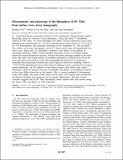| dc.contributor.author | Yao, Huajian | |
| dc.contributor.author | Montagner, Jean-Paul | |
| dc.contributor.author | van der Hilst, Robert D | |
| dc.date.accessioned | 2014-03-27T16:00:53Z | |
| dc.date.available | 2014-03-27T16:00:53Z | |
| dc.date.issued | 2010-12 | |
| dc.date.submitted | 2010-05 | |
| dc.identifier.issn | 0148-0227 | |
| dc.identifier.uri | http://hdl.handle.net/1721.1/85927 | |
| dc.description.abstract | Understanding the geotectonic evolution of the southeastern Tibetan plateau requires knowledge about the structure of the lithosphere. Using data from 77 broadband stations in SW China, we invert Rayleigh wave phase velocity dispersion curves from ambient noise interferometry (T = 10–40 s) and teleseismic surface waves (T = 20–150 s) for 3-D heterogeneity and azimuthal anisotropy in the lithosphere to ∼150 km depth. Our surface wave array tomography reveals (1) deep crustal zones of anomalously low shear wave speed and (2) substantial variations with depth of the pattern of azimuthal anisotropy. Upper crustal azimuthal anisotropy reveals a curvilinear pattern around the eastern Himalayan syntaxis, with fast directions generally parallel to the main strike slip faults. The mantle pattern of azimuthal anisotropy is different from that in the crust and varies from north to south. The tomographically inferred 3-D variation in azimuthal anisotropy helps constrain the source region of shear wave splitting. South of ∼26°N (off the high plateau) most of the observed splitting can be accounted for by upper mantle anisotropy, but for stations on the plateau proper (with thick crust) crustal anisotropy cannot be ignored. On long wavelengths, the pattern of azimuthal anisotropy in the crust differs from that in the mantle. This is easiest explained if deformation varies with depth. The deep crustal zones of low shear wave speed (and, presumably, mechanical strength) may represent loci of ductile deformation. But their lateral variation suggests that in SE Tibet (localized) crustal channel flow and motion along the major strike slip faults are both important. | en_US |
| dc.language.iso | en_US | |
| dc.publisher | American Geophysical Union | en_US |
| dc.relation.isversionof | http://dx.doi.org/10.1029/2009jb007142 | en_US |
| dc.rights | Article is made available in accordance with the publisher's policy and may be subject to US copyright law. Please refer to the publisher's site for terms of use. | en_US |
| dc.source | Other univ. web domain | en_US |
| dc.title | Heterogeneity and anisotropy of the lithosphere of SE Tibet from surface wave array tomography | en_US |
| dc.type | Article | en_US |
| dc.identifier.citation | Yao, Huajian, Robert D. van der Hilst, and Jean-Paul Montagner. “Heterogeneity and Anisotropy of the Lithosphere of SE Tibet from Surface Wave Array Tomography.” Journal of Geophysical Research 115, no. B12 (2010). | en_US |
| dc.contributor.department | Massachusetts Institute of Technology. Department of Earth, Atmospheric, and Planetary Sciences | en_US |
| dc.contributor.mitauthor | Yao, Huajian | en_US |
| dc.contributor.mitauthor | van der Hilst, Robert D. | en_US |
| dc.relation.journal | Journal of Geophysical Research | en_US |
| dc.eprint.version | Final published version | en_US |
| dc.type.uri | http://purl.org/eprint/type/JournalArticle | en_US |
| eprint.status | http://purl.org/eprint/status/PeerReviewed | en_US |
| dspace.orderedauthors | Yao, Huajian; van der Hilst, Robert D.; Montagner, Jean-Paul | en_US |
| dc.identifier.orcid | https://orcid.org/0000-0003-1650-6818 | |
| mit.license | PUBLISHER_POLICY | en_US |
| mit.metadata.status | Complete | |
